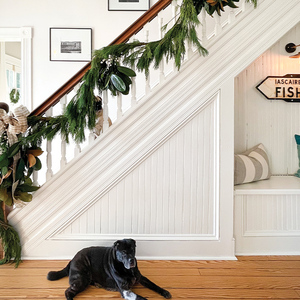I have a project where the house has two “wings” served by the same hvac unit. The temp variations are signficant between the two so simply choking down one side works for narrow temperature ranges, but fails when heating turns to cooling, and with extremes of either heating or cooling.
I’ve seen 2 dampers and 2 separate thermastats work with two separate areas of a house, but can’t say who makes the equipment let alone the better ways of doing this. What have you guys used that worked well? Is there a separate smart board that everything is wired into or is it simpler than that?
The main reason for not going to two units is space, and because the existing unit is sized correctly.
Beer was created so carpenters wouldn’t rule the world.















Replies
You can purchase a separate "smart board" that sits between thermostats and furnace/AC and controls the dampers. We have an EWC Controls "Ultrazone" unit. Cost about $700 installed. Handles up to three zones.
Does that 700 include everything (dampers, thermastat, board, etc.)?
Beer was created so carpenters wouldn't rule the world.
Don't recall for sure what that included. I think it was just the board. But that was list & installed.
Corporation: n. An ingenious device for obtaining individual profit without individual responsibility. --Ambrose Bierce
Ask your HVAC installer about modifying it to a "zoned bypass" system.
------------------
"You cannot work hard enough to make up for a sloppy estimate."
I sorta wanted to figure out the basics before asking him for anything. Sort of like asking an electrican for can lights....he'll put them whereever and in whatever number he likes regardless of what really makes sense! No offense to any of the trades! :-)
Beer was created so carpenters wouldn't rule the world.
Sure thing, the basic approach here would be to zone the system by installing dampers that would shut down the ducts that don't need air. this restricts the air flow over the heat exchanger and accelerates the flow and noise through the open ducts. A zoned bypass system opens a bypass damper whenever a zone damper closes (generally you'll have two zone dampers and one bypass damper) this allows the air that would have gone to the closed zone to bypass back through the heat exchanger a second time making it either colder and dryer in the summer or hotter in the winter while the air coming out of the open zone stays the same velocity and sound level. It's a step up from the standard zoned system but it can freeze up in the summer if you don't install a sensor on the heat exchanger that shuts down the compressor but leaves the circulation fan running if the temp drops below 40 degrees on the coil.------------------
"You cannot work hard enough to make up for a sloppy estimate."
Thanks for the info on the bypass, for a single speed blower that sounds like the better way to go.
Beer was created so carpenters wouldn't rule the world.
We've done it with variable speed blowers as well but the installer was pretty savvy to figure it all out. I suspect there was a high tech circuit board involved at the unit.------------------
"You cannot work hard enough to make up for a sloppy estimate."
Thanks for the info!
Beer was created so carpenters wouldn't rule the world.
Can't remember who did the poor man's zone system ... Carrier maybe? It was one of the major manufacturers of systems (Carrier, Trane, uh who else ... mind's fading). I don't recall what they've called these things ... I deal w/ mostly commercial that do this type of thing all the time ... residential over the years has been taking on a more and more commercial flavor at times when it makes sense.
Not sure of your situation. You said "The temp variations are signficant between the two ..." What temp variations are you referring to? Outside temps? Inside temp needs? Loads (internal/external)?
If ducts are sized properly, you should be able to heat/cool different areas to apropriate levels. This may not be the case if you have large disparities in e.g. exposure (or other loads) where solar gain in one area is huge and non existent in another.
A simple dampered system w/ some ties, controls, safety back to the heating/cooling system will help you, though. The dampers are controlled by the thermostats. Thinking out loud ... seems like these two stats will tie into a central control that turns on/off the heat/cool and provides ways for that system to operate properly (i.e. not get too hot/cold).
You should be able to find a system on line that fits the bill, though. A good experienced HVAC tech/company should already know this option, though. But maybe you need to turn him on to it assuming he's 'trainable'. :) No offense to any trades.
Not sure of your situation. You said "The temp variations are signficant between the two ..." What temp variations are you referring to? Outside temps? Inside temp needs? Loads (internal/external)?
It's much like an old and relatively new house being joined by a walkway with the thermastat in the old house--simply choking down the supply to the old side doesn't midigate the crazy temp swings.
The past contractor used suplimental electrical heat in the cold sections instead of fixing the furnace issue.
"If ducts are sized properly..."
They aren't. Primarily it's a shortfall on the return because the old returns on under the slab and the new construction wasn't tied into the return at all. We'll retrofit a new return trunk, but that's going to increase our air delivery into the new section not take care of the differing loads.
, you should be able to heat/cool different areas to apropriate levels. This may not be the case if you have large disparities in e.g. exposure (or other loads) where solar gain in one area is huge and non existent in another.
One "wing" of the house is old and not well insulated, but with more solar gain, while the other end is relatively new construction but on the north end of the house. Also, the occupants of the older section like temps a few degrees warmer year round than the occupant of the newer section.
All the temp variations make the house feel draftier than it really is.
You should be able to find a system on line that fits the bill, though. A good experienced HVAC tech/company should already know this option, though. But maybe you need to turn him on to it assuming he's 'trainable'. :) No offense to any trades.
Luckily I have a top notch HVAC guy with a world class installer and we've rebuilt many historical houses together, but in the past we've been able to simply install separate new systems in this situation, or optimize for cooling and add suplimental radiant heat. Revamping the HVAC wasn't originally included in my new project, but badly needs to be done, so I'm trying to improve the situation while not breaking the budget for the primary work. $10k in furnace upgrades would have to come out of the budget for one of the bathrooms.
Beer was created so carpenters wouldn't rule the world.
Maybe do a full two zone VAV or maybe a constant volume reheat w/ temperature reset ... maybe not since you don't have hydronic heat ... you'd have to add that. And w/ DX cooling it really doesn't work, either.
I think you could still do the poor mans VAV w/ the simple dampers that are controlled by stats in the separate areas. You do need to get some return, though, too. Can you duct some return through the walkway? Do you have balancing dampers at all?
You got a situation. Your HVAC dude should be able to help sort through options. Maybe look at some commercial type options for some ideas and then bring it back to you.
One option is to level the loads by insulating the old section more and maybe mitigating some of the solar disparity w/ tinting and/or overhangs/shading. Load disparity is conceptually perfect for VAV, but that maybe awkward for your situation.
One option: do hydronic baseboard heat in one of the units for heating?
Can you duct some return through the walkway? Do you have balancing dampers at all?
There is plenty of space in the attic to run a decent return, the problem is getting it to the bottom of the furnace (the return air system is under the slab).
We are in primarily a heating climate so the returns should have been up high, but the originals were installed pre-AC so that's all they knew. As easy as the access is if we had an extra grand in the budget we'd rerun all the returns.
As for insulating the old section, it's my normal SOP to insulate all attic space we can reach to R50-R60, but anything in the walls is so far beyond the scope of the project it's probably going to have to wait.
Beer was created so carpenters wouldn't rule the world.
DuroDyne/DuroZone is one of the residential zoning systems available from most general HVAC distributors (i.e. Berkheimer, Ferguson). Its a little on the low end side of things. A better system, if its still available (its been a few years since I was involved directly with these systems) is the Honeywell Trol-a-temp system http://customer.honeywell.com/Honeywell/UI/Pages/Catalog/SystemCategory.aspx?Catalog=Homes&Category=Conventional+Zoning_132&ChannelID=%7b2EB2F178-20ED-44E0-97FB-CCFB4218DD64%7d
For clarification, a bypass type of zone system, as specifically applied to a constant volume residential furnace, operates with a counter balanced bypass damper that responds to system pressure. As the zone dampers close, the system pressure builds and causes the bypass to open. In larger (commercial) bypass VAV systems (sometimes refered to as VVT system) a pressure transducer and supply air temperature sensor provide control input to the motor operated bypass damper. A true variable air volume (VAV) system modulates the fan speed to control system back pressure (measured in the supply duct system at a "representative" location) via an electrically commutated motor (ECM) in small systems or with a variable frequency drive in larger systems.
Edited 10/14/2008 2:33 pm by Tim